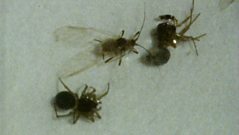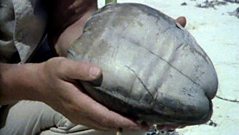
Hot air
Vultures use the rising hot air of thermals to soar high and scan for carcasses.
David Attenborough goes on a hot air balloon flight over the Serengeti. The balloon uses hot air to give it lift and rise into the sky. In the same way, the land is heated by the sun. But some parts of the land absorb heat while other parts of the land will reflect the heat, creating uprising columns of air called thermals. Vultures have large unwieldy wings that take a lot of energy to use. So in the mornings they simply use their wings to get from one low tree to another. But when the land has heated up later in the day, then there are thermals to ride. They use the thermals to provide them with an observation post high in the sky so that they can scan the planes below. From his vantage point David is able to see a herd of wildebeest, perhaps the largest gathering of meat on the hoof in the world. Soaruing vultures can quickly spot a kill or deduce its presence by the behaviour of birds in a neighbouring thermal. Once one bird has found the carcass of a wildebeest calf, dozens will arrive within a few minutes. Most of the ones that turn up in this instance are medium-sized vultures - Ruppell's Griffon and white-backed - but amongst them is the largest and most powerful of the African vultures: the lappet-faced vulture. Heavy with meat, they will not fly far - only back to the perch or nest where they can digest.
Duration:
This clip is from
Featured in...
![]()
成人快手 Nature
Be captivated, informed and inspired by the world's wildlife.
More clips from The Sky Above
-
![]()
Flaps for flight
Duration: 01:40
-
![]()
Flying blind
Duration: 01:58
-
![]()
Superhigh life
Duration: 04:19
-
![]()
Smashing scavengers
Duration: 03:01
More clips from The Living Planet
-
![]()
Ocean Drifters—Worlds Apart
Duration: 01:20
-
![]()
Snare of silk—The Baking Deserts
Duration: 01:48
-
![]()
Furnace flora—The Baking Deserts
Duration: 03:46
-
![]()
Ships of the desert—The Baking Deserts
Duration: 03:17










